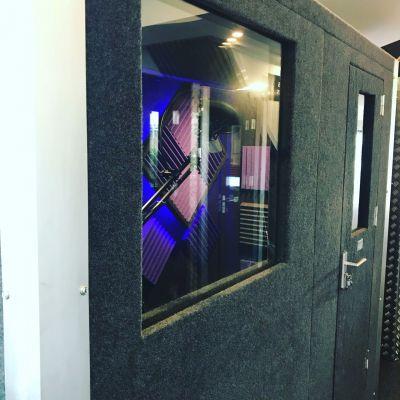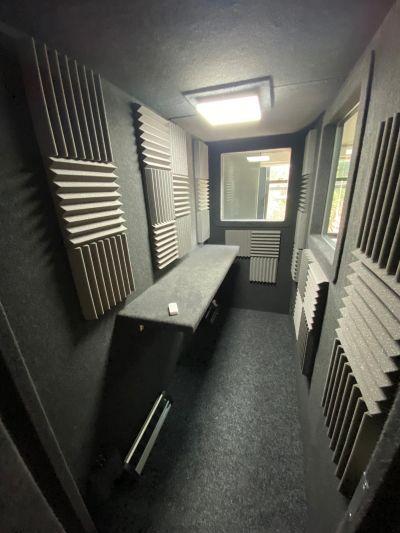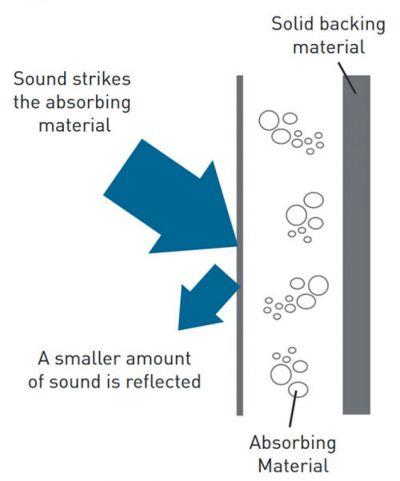Manufacturers of Vocal Booths
and Sound Isolation Enclosures
UK Freephone: 0800 170 1271
International: +44 (0) 7300 332 268
Email: Sales@kubevocalbooth.com
Follow Us:
Voice Over Booths & Voice Over Sound Isolation Enclosures

Do you need an acoustically treated space for voice over work, but don’t know where to start? The following information has been put together to help you on your journey.
So, let’s start with the noise reduction. Nuisance noises are the biggest issue when it comes down to recording a high-quality audio take. The noise floor of your recording space is very important, so much so, that if it is not satisfactory, all the hard work you have put into recording the best voice work you’ve ever done, will be rejected straight away by any quality engineer.
We often get asked, what is noise floor exactly. Here is a brief description
The first part is background noise (all the unwanted noise). Imagine a room acting as the level of noise and at its loudest it being right up at the ceiling, in turn at the quietest, being down low on the floor – that’s the noise floor. So, the aim is to keep the volume on unwanted noise, at floor level.
Along with unwanted background noise, you also need to consider any electrical equipment, as all electrical equipment generates its own noise. This is often not heard by the human ear but can be picked up by your microphone.
It is always best to turn off any electrical devices not in use and to keep as much equipment outside of your recording space.
The most common issues that a voice over artist would face regarding a good noise floor are –
1: Background noise (traffic, nature, neighbours, pets etc)
2: Reverberation and Echo’s – the acoustic sounds reflected off hard surfaces within your recording space.
3: Electrical interference (devices in use, WiFi, unnecessary signaling devices within range – mobile phones, tablets and even watches these days)
4: Plosives - Air that hits the microphone causing a distorted thud sound.
5:Sibilance – Very similar to plosives but at a higher frequency.
Now we have a general idea of the issues, let’s look at the solutions to create the perfect recording space.
“Creating A Room Within A Room”Soundproofing and Isolation – This is where we come in!
Although there are many recommended ways to reduce sound levels, the key elements are creating mass, air gaps & isolation from the outside world.
Our Silver Range Isolation booths are our most popular booths for VO work and have been tried, tested, and loved by many VO artists over the years.
The Silver Range offers isolation from the outer world by creating a room within a room set up.
What is isolation?

Isolation of sound is the decoupling of a space to isolate it from its surroundings, often called creating a room within a room.
Think back to when you last stayed in a hotel on a busy road, most hotels would have two windows, an outer ordinary window and directly behind that, a secondary sliding glass window. The secondary glass layer is isolated (has a clear gap between) from the outer window. The reason for this is simply to drown out the last bit of traffic noise.
The external traffic noise on a busy road, on average, would be around 85dB. The first outer window would likely reduce this to around 60-65dB, which is great, but still at the level of someone talking in your room. This is where the secondary window comes in, this secondary window now only has to reduce 65dB, which has a much lesser power output than 85dB, so a seemingly thin piece of glass, circa 3-4mm would then reduce the traffic noise to around 40dB, which is an ambient peaceful level.
Our isolation booths work on the same principle but with much better results, whether its unwanted external noise or simply noise from the next room. This is the perfect solution to the main issue with a bad noise floor, eliminating all unwanted background noise.
Understanding Sound Levels In Everyday Life
| dB Level | Examples | Power Ratio |
| 10 | Normal Breathing | 10 |
| 20 | Rustling Leaves - Distant | 100 |
| 30 | Whispering | 1000 |
| 40 | Library | 10,000 |
| 50 | Moderate Rain Fall | 100,000 |
| 60 | Normal Conversation | 1,000,000 |
| 70 | Traffic | 10,000,000 |
| 80 | Vacuum Cleaner | 100,000,000 |
| 90 | Shouting | 1,000,000,000 |
| 100 | Chainsaw | 10,000,000,000 |
| 110 | Night Club Music | 100,000,000,000 |
| 120 | Rock Concert | 1,000,000,000,000 |
| 130 | Threshold of Pain | 10,000,000,000,000 |
| 140 | Jet Engine at Take Off | 100,000,000,000,000 |
| 150 | Fire Works at 1m | 1,000,000,000,000,000 |
| 190 | Loudest Possible True Sound | 1.00E+19 |
Acoustic Treatment


The next most important aspect for a quality recording and for reducing the noise floor even further, is acoustic treatment. This is not the be confused with sound reduction.
‘Acoustics’ is how sound is heard by the human ear or indeed a recording device.
For example, when you first move into a new house with no curtains, sofas, or any soft furnishings, you will find that each room has an echo. Once you have moved your sofa in, popped your rugs down and get your curtains up, that echo seems to just disappear.
This is due to the sound being absorbed by the soft furnishing that you have put in place.
Reverberating sounds and echoes are both bad news when it comes to recording vocals. The easiest way to reduce them is by creating a sound absorbent space through soft furnishings.
There are many ways to do this, from acoustic blankets to studio foam tiles and panels. At Kube, we have created a VO acoustic pack which supplies you with studio-grade acoustic foam tiles and bass traps leaving you with the perfect space to create.
Electrical interference
Electrical interference can be a common problem when recording audio, and there are several things you can do to help reduce or eliminate it. Here are a few tips:
1.Use balanced cables: Balanced cables have three wires instead of two, and they help cancel out any electrical interference that may be picked up along the cable. Using balanced cables between your audio interface and your recording device can help reduce interference.
2.Use a power conditioner: Power conditioners help to stabilize the voltage going to your recording equipment, which can help reduce interference caused by fluctuations in the electrical supply.
3.Keep cables away from power sources: Try to keep your cables as far away from power sources as possible. Power cords and electrical devices can create electromagnetic fields that can interfere with your audio signal.
4.Use a ground lift: If you are experiencing a ground loop, which is a type of interference caused by multiple ground connections, you can use a ground lift to break the loop and eliminate the interference.
5.Use a noise gate: If you are still experiencing interference, you can use a noise gate to remove any unwanted noise from your recording. A noise gate is a type of processor that removes any signal below a certain threshold, so it can help to eliminate any unwanted noise.
By following these tips, you should be able to reduce or eliminate any electrical interference when recording audio.
Plosives & Sibilance
A plosive is a type of sound that is created by a sudden burst of air from the mouth. Plosives are typically produced by consonant sounds such as "p," "b," and "t." When a person produces a plosive sound, they momentarily stop the flow of air from the lungs and then release it in a sudden burst, which creates a noticeable burst of sound.
When recording audio, plosives can be problematic because they can cause distortion or popping sounds, which can be unpleasant to listen to Therefore, it's important to use a pop filter or to position the microphone correctly to reduce the impact of plosives on the recording.
A good example of a plosive, for the fans of the TV series Friend’s is – “I’ve got a Picture of Penelope in my Pocket!”
Sibilance is a type of sound that is created by an emphasis on the "s" and "sh" sounds in speech. These sounds are produced by a turbulent airflow that is created when air passes through a narrow channel formed by the tongue, teeth, and lips. Sibilance is a common problem when recording audio, and it can cause a harsh, hissing sound that can be distracting or unpleasant to listen to.
Sibilance is most heard in spoken words that contain the letters "s" and "sh," such as "sister," "shine," and "pressure." When recording vocals, sibilance can be problematic because it can cause distortion or a harsh sound that can be difficult to correct in post-production. To reduce the impact of sibilance, a de-esser can be used, which is a type of processor that is designed to reduce the emphasis on the "s" and "sh" sounds. It is also important to use proper microphone technique and positioning to help reduce the impact of sibilance on the recording.
Plosives and sibilance are common problems when recording vocals, but there are several things you can do to reduce or eliminate them
1. As mentioned above, use a pop filter: A pop filter is a screen that is placed in front of the microphone to help reduce plosives. Plosives are caused by bursts of air from the mouth hitting the microphone diaphragm, and a pop filter can help to disperse the air and reduce the impact.
2. Adjust the microphone position: Position the microphone slightly off to the side of the mouth to reduce plosives. You can also angle the microphone slightly above or below the mouth to help reduce sibilance.
3. Use a low-cut filter: A low-cut filter, also known as a high-pass filter, can help to reduce plosives by cutting out the low-frequency rumble that is often associated with them.
4. Use a de-esser: A de-esser is a type of processor that is used to reduce sibilance. Sibilance is caused by an emphasis on the "s" and "sh" sounds in speech, and a de-esser can help to reduce this emphasis.
5. Use proper mic technique: Encourage the vocalist to maintain a consistent distance from the microphone and to speak directly into it without moving around too much. This will help to maintain a consistent sound and reduce the likelihood of plosives and sibilance.
Final Thoughts
We hope that this information has helped to guide you on your way to get the best recording sound possible.
Through feedback from our customers and our own tests and experience, Vocal Booths are an essential tool for recording professional-quality audio. They provide an isolated environment for recording vocals, voice-overs, and other spoken-word content.
One of the primary benefits of vocal booths is their ability to isolate the sound source from external noise. Recording studios can be noisy environments, with ambient sounds such as traffic, air conditioning, and people talking. Vocal booths help to block out these sounds, allowing for a clean recording.
Improved acoustics
The interior of each vocal booth is lined with enough sound-absorbing acoustic foam, to cover approximately a third of the space, which help to reduce the amount of reverberation in the room. This creates a more controlled, non-reflective sound, which is essential for professional recordings.
Consistency
Vocal booths provide a consistent recording environment, which is essential for producing high-quality audio. When recording in a different room, the acoustics and background noise can change, which can affect the final recording. With a vocal booth, the recording environment is always the same, which ensures consistency across all recordings.
Privacy
If you are recording sensitive content, such as voice-overs for a commercial, a vocal booth can provide a private and secure environment. This is particularly important for voice-over work, where confidentiality is essential.
Flexibility
They are not just limited to recording vocals or voice-overs, but can also be used for recording instruments or sound effects. This makes them a valuable tool for recording studios, film production companies, and other creative industries.
Portability
This means that they can be easily moved from one location to another, making them ideal for use in a range of settings. Portable vocal booths are particularly useful for on-location recording, such as recording voice-overs for a video shoot.
Versatility
Vocal booths come in a range of sizes and styles, which makes them versatile and suitable for a variety of recording needs. Some vocal booths are designed to accommodate a single person, while others are large enough to fit a small band or orchestra. There are also different styles of vocal booths available, such as standalone booths or booths that can be integrated into a recording studio.
Cost-effective
While they may seem expensive to purchase, they can save money in the long run by reducing the need for costly post-production editing. Recording in a vocal booth can also save time and money by reducing the need for re-takes, as the quality of the recording is often higher than when recorded in a different environment.
Professionalism
A high-quality vocal booth can create a professional and polished sound, which can be particularly important for commercial recordings or recordings that are intended for public consumption.
We can show you specific decibel (db) readings of both inside and outside our different sound booths.
A Few Of Our Clients